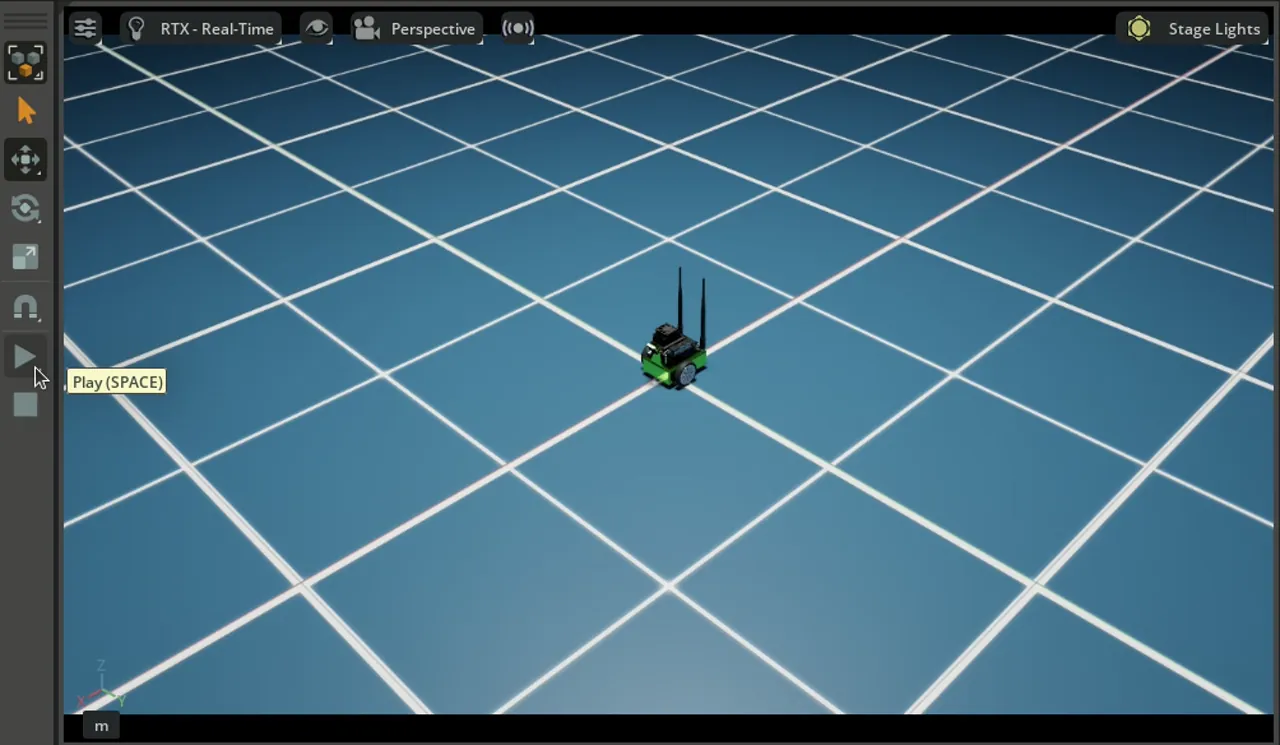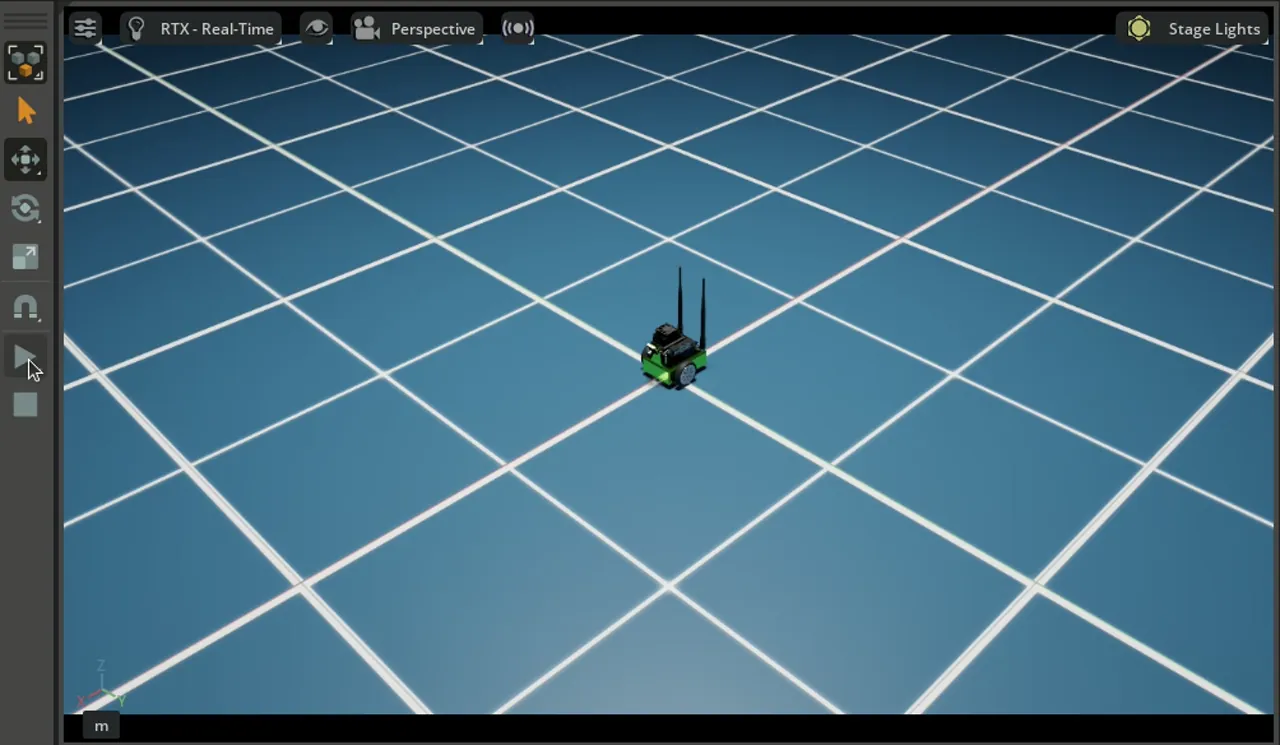Adding a Controller#
Learning Objectives#
This tutorial describes how to create and use a custom controller to move a mobile robot. It then describes how to use the controllers available in NVIDIA Isaac Sim. After this tutorial, you should be more comfortable with adding and controlling robots in NVIDIA Isaac Sim.
10 Minute Tutorial
Getting Started#
Prerequisites
Review Hello Robot prior to beginning this tutorial.
Begin with the source code open from the Hello Robot tutorial, by clicking the Open Source Code button in the Hello World Example window.
Note
Pressing STOP, then PLAY in this workflow might not reset the world properly. Use the RESET button instead.
Creating a Custom Controller#
First, code an open-loop controller that uses the unicycle model for differential drive. Controllers in NVIDIA Isaac Sim inherit from the BaseController interface. You will need to implement a forward method, and it has to return an ArticulationAction type.
1from isaacsim.examples.interactive.base_sample import BaseSample 2from isaacsim.core.utils.nucleus import get_assets_root_path 3from isaacsim.robot.wheeled_robots.robots import WheeledRobot 4from isaacsim.core.utils.types import ArticulationAction 5from isaacsim.core.api.controllers import BaseController 6import numpy as np 7 8 9class CoolController(BaseController): 10 def __init__(self): 11 super().__init__(name="my_cool_controller") 12 # An open loop controller that uses a unicycle model 13 self._wheel_radius = 0.03 14 self._wheel_base = 0.1125 15 return 16 17 def forward(self, command): 18 # command will have two elements, first element is the forward velocity 19 # second element is the angular velocity (yaw only). 20 joint_velocities = [0.0, 0.0] 21 joint_velocities[0] = ((2 * command[0]) - (command[1] * self._wheel_base)) / (2 * self._wheel_radius) 22 joint_velocities[1] = ((2 * command[0]) + (command[1] * self._wheel_base)) / (2 * self._wheel_radius) 23 # A controller has to return an ArticulationAction 24 return ArticulationAction(joint_velocities=joint_velocities) 25 26 27class HelloWorld(BaseSample): 28 def __init__(self) -> None: 29 super().__init__() 30 return 31 32 def setup_scene(self): 33 world = self.get_world() 34 world.scene.add_default_ground_plane() 35 assets_root_path = get_assets_root_path() 36 jetbot_asset_path = assets_root_path + "/Isaac/Robots/NVIDIA/Jetbot/jetbot.usd" 37 world.scene.add( 38 WheeledRobot( 39 prim_path="/World/Fancy_Robot", 40 name="fancy_robot", 41 wheel_dof_names=["left_wheel_joint", "right_wheel_joint"], 42 create_robot=True, 43 usd_path=jetbot_asset_path, 44 ) 45 ) 46 return 47 48 async def setup_post_load(self): 49 self._world = self.get_world() 50 self._jetbot = self._world.scene.get_object("fancy_robot") 51 self._world.add_physics_callback("sending_actions", callback_fn=self.send_robot_actions) 52 # Initialize our controller after load and the first reset 53 self._my_controller = CoolController() 54 return 55 56 def send_robot_actions(self, step_size): 57 #apply the actions calculated by the controller 58 self._jetbot.apply_action(self._my_controller.forward(command=[0.20, np.pi / 4])) 59 return

Using the Available Controllers#
NVIDIA Isaac Sim also provides different controllers under many robot extensions. Re-write the previous
code using the DifferentialController class and add a WheelBasePoseController.
1from isaacsim.examples.interactive.base_sample import BaseSample 2from isaacsim.core.utils.nucleus import get_assets_root_path 3from isaacsim.robot.wheeled_robots.robots import WheeledRobot 4# This extension includes several generic controllers that could be used with multiple robots 5from isaacsim.robot.wheeled_robots.controllers.wheel_base_pose_controller import WheelBasePoseController 6# Robot specific controller 7from isaacsim.robot.wheeled_robots.controllers.differential_controller import DifferentialController 8import numpy as np 9 10 11class HelloWorld(BaseSample): 12 def __init__(self) -> None: 13 super().__init__() 14 return 15 16 def setup_scene(self): 17 world = self.get_world() 18 world.scene.add_default_ground_plane() 19 assets_root_path = get_assets_root_path() 20 jetbot_asset_path = assets_root_path + "/Isaac/Robots/NVIDIA/Jetbot/jetbot.usd" 21 world.scene.add( 22 WheeledRobot( 23 prim_path="/World/Fancy_Robot", 24 name="fancy_robot", 25 wheel_dof_names=["left_wheel_joint", "right_wheel_joint"], 26 create_robot=True, 27 usd_path=jetbot_asset_path, 28 ) 29 ) 30 return 31 32 async def setup_post_load(self): 33 self._world = self.get_world() 34 self._jetbot = self._world.scene.get_object("fancy_robot") 35 self._world.add_physics_callback("sending_actions", callback_fn=self.send_robot_actions) 36 # Initialize our controller after load and the first reset 37 self._my_controller = WheelBasePoseController(name="cool_controller", 38 open_loop_wheel_controller= 39 DifferentialController(name="simple_control", 40 wheel_radius=0.03, wheel_base=0.1125), 41 is_holonomic=False) 42 return 43 44 def send_robot_actions(self, step_size): 45 position, orientation = self._jetbot.get_world_pose() 46 self._jetbot.apply_action(self._my_controller.forward(start_position=position, 47 start_orientation=orientation, 48 goal_position=np.array([0.8, 0.8]))) 49 return
Press Ctrl+S to save and hot reload the example. Then press the LOAD button to reload
the scene.

Summary#
This tutorial covered the following topics:
Creating a custom controller to move a mobile robot
Using Controller classes from NVIDIA Isaac Sim
Next Steps#
Continue to the next tutorial in the Essential Tutorials series, Adding a Manipulator Robot, to learn how to add a manipulator robot to the simulation.